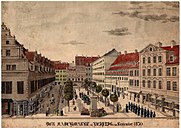Castle cellar
The Burgkeller is the oldest verifiable public tavern in Leipzig and for several centuries had the sole privilege of serving and selling foreign beers in the city .
history
The first documented mention of a castle cellar - standing for citizen cellar - in Leipzig dates back to 1419. No information is given here about the exact location, only the information that the cellars of the bar were on the market . In 1459, through a privilege granted by Elector Friedrich II, the city's castle cellar was given sole permission to import, serve and sell foreign beers. The institution had this exclusive right until 1839 and was thus at times an important source of income for Leipzig. In 1565 the city built a complex of houses between Naschmarkt and Reichsstrasse , in which, in addition to the castle cellar, the city's meat and bread banks , cookshops and initially the shoemaker's and furrier's guilds were located. The castle cellar was located in the basement and ground floor of a two-story building block on the Naschmarkt side, it was expanded in 1572.
In 1621, at the request of the Leipzig craft guilds, the building was partially extended and an additional drinking room was set up on the second floor . In 1859 the Leipzig meat banks moved to the Georgenhalle and the castle cellar took over the premises in Reichsstraße. In the following years, the representative Renaissance building with eye-catching ornamental gables was extensively expanded and expanded. An imposing three-part dining room, an ice cellar and a large pantry as well as a modern kitchen were created with a focus on the hospitality industry. For this purpose, modern gas lighting and water connections were installed in the building . The transport of beer barrels was organized in the inner courtyard .
In 1905 it was decided to rebuild the entire complex between Naschmarkt and Reichsstraße - also known as the Burgkellerblock - and from 1907 to 1908 the historic square was demolished . A year later, the Handelshof , an urban trade fair palace designed by Georg Weidenbach and Richard Tschammer , was inaugurated at the same location . In 1908, the Leipzig city planning officer Otto Wilhelm Scharenberg began building a school building in Leipziger Möbiusstraße (today Humboldt-Gymnasium ) and erected a monument to the demolished gable of the castle cellar by quoting it several times on the new school building. It is even said that material from the demolition gable was used.
When the new Handelshof was built, the castle cellar was taken into account as a historically significant institution of the city; on the Naschmarkt side, in its original location, rooms were furnished with architectural reference to the old inn. In 1913 the Sternburg brewery from Lützschena took over the inn, which it operated until 1955.
After the heavy air raid on Leipzig in the night of December 4, 1943 , the Handelshof was severely damaged and partially burned down. Shortly after the end of the Second World War , external parts of the building could be restored at least temporarily. In 1947 the Burgkellercafé with 300 seats with a conference room was opened on the corner of Naschmarkt and Grimmaische Strasse , and a bar was to be found in the basement . In 1955, the Burgkeller was used as an HO restaurant until the end of the GDR , and during these decades there was a cocktail bar and specialty restaurants in the cellar. In 1991 Leipziger Messe GmbH acquired the entire building complex and sold it on in 2005. A comprehensive renovation of the entire house took place from 2007 to 2011. The former castle cellar on the Naschmarkt side at the corner of Grimmaische Strasse is still operated as a restaurant by various tenants.
literature
- Something about the old Leipzig beer bar . In: The Leipziger. Illustrierte Wochenschrift (1921), No. 27, pp. 638–639.
- Arno Kapp, Oswald Winde: History of the Leipziger Burgkeller , Leipzig 1931.
- Herbert Pilz: Beer and beer tavern in old Leipzig . In: Leipziger Calendar 1996 , Leipziger Universitätsverlag, Leipzig 1996, ISBN 3-930846-09-8 , pp. 98–113.
- Herbert Pilz: Enjoy yourself and enjoy your meal. Leipzig gastronomy history (s) . Leipziger Medien Service (Leipziger Volkszeitung), Leipzig 2011, ISBN 978-3-942360-04-3 , pp. 20–24.
- Wilma Rambow: "the cellar czu nucze schenghuse". The "Burgkeller" - on the history of the city's oldest tavern and inn . In: Leipziger Blätter (2013), No. 62, pp. 26–29.
Web links
Individual evidence
- ^ Carl Friedrich von Posern-Klett (Ed.): Document book of the city of Leipzig . Volume 1: No. 132, 1419. Jan. 11 (= Codex diplomaticus Saxoniae regiae. Main part, 2nd volume 8), Giesecke & Devrient, Leipzig 1868, p. 84. ( digitized version )
- ↑ Wilma Rambow: "the cellar czu nucze schenghuse". The "Burgkeller" - on the history of the city's oldest tavern and inn . In: Leipziger Blätter (2013), No. 62, p. 26.
- ^ Heinz Lohse : 100 years of the school building in Möbiusstrasse 8 . In: The Humboldt School through the ages - On the 100-year history of a Leipzig high school, Part 1 1910–1960. 3rd edition, Leipzig 2011, DNB 102528447X , p. 7





